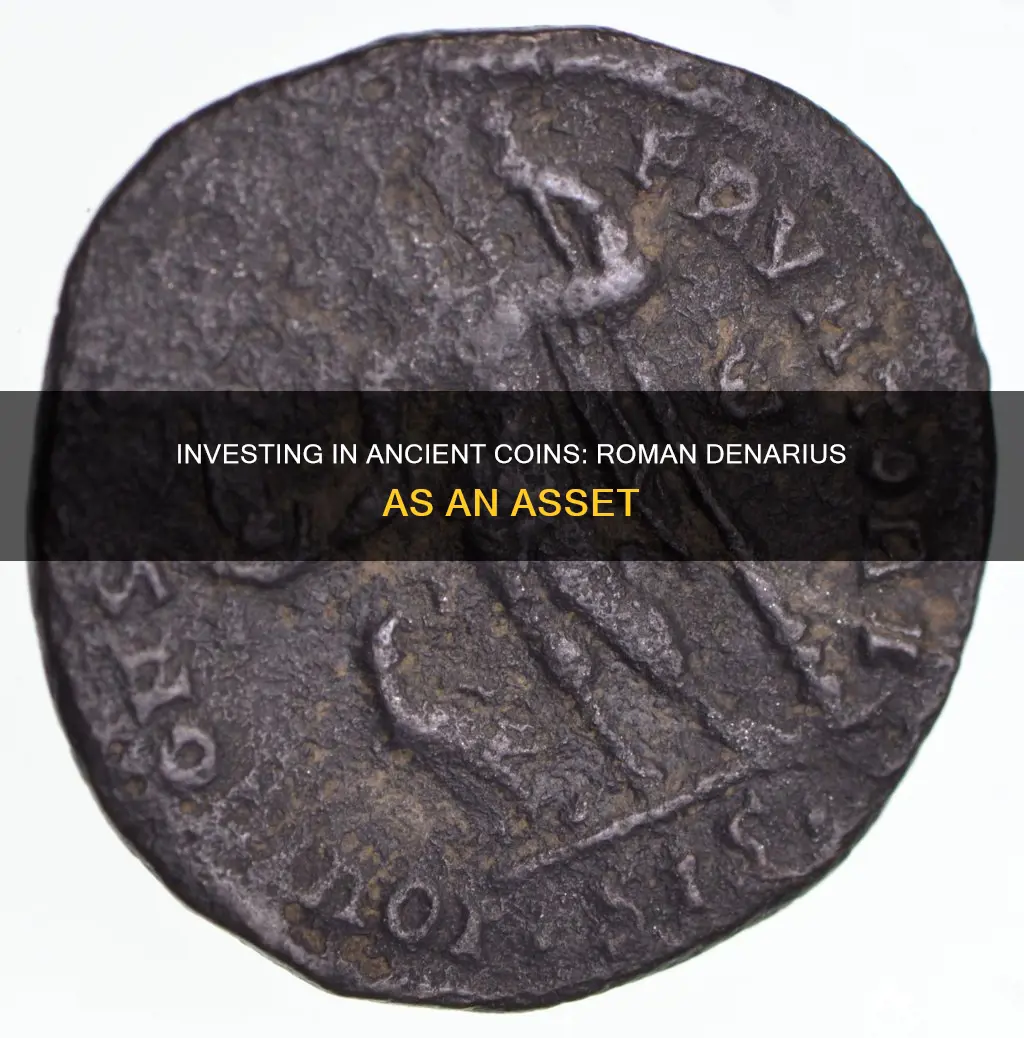
Silver Roman Denarius coins are an affordable way to start collecting ancient coins. They are also a good investment option, given their historical significance and aesthetic beauty. The Roman Denarius was the standard Roman silver coin from its introduction in 211 BC to the reign of Gordian III (AD 238-244). It was originally valued at 10 asses, which gave it the name 'denarius', meaning 'containing ten' in Latin. The coin was in use until the 3rd century AD, making it the longest-surviving denomination of Roman coin. Its longevity and importance to the Roman economy make it a sought-after item for collectors.
What You'll Learn
- Silver denarius coins are affordable and perfect for collectors and history enthusiasts
- Silver denarius coins are a good investment due to their historical significance
- The value of silver denarius coins varies according to their condition and rarity
- Silver denarius coins were introduced in 211 BC and were replaced by the antoninianus in the early 3rd century AD
- Silver denarius coins were used as a unit of account even after they were no longer issued

Silver denarius coins are affordable and perfect for collectors and history enthusiasts
Silver denarius coins are a great choice for collectors and history enthusiasts, offering an affordable way to own a piece of ancient Roman history. With a history spanning from 211 BC to the reign of Gordian III (AD 238-244), the denarius was the standard Roman silver coin and played a crucial role in the Roman economy.
These coins are not only affordable but also highly collectible. They are easy to sell and can be a good investment, especially when in high conservation. The value of these coins can vary greatly, with some specimens in good condition priced around $100, while others can reach hundreds of thousands of dollars. The famous denarius commemorating the Ides of March and the assassination of Julius Caesar is a testament to the historical significance and value of these coins.
The denarius is a small silver coin, pleasant to collect, and easy to display. The designs on these coins feature divinities and emperors, making them a fascinating glimpse into the past. Emperors featured on these coins include Vespasian, Faustina, Elagabalus, Caracalla, Antoninus Pius, and Gordian III.
For those interested in ancient history, Roman culture, or simply looking for an affordable way to start a coin collection, the silver denarius coins are an excellent choice. They offer a tangible connection to the past and provide a unique insight into the economic and social life of the Roman Empire.
NYSE Bitcoin Trading: A Beginner's Guide
You may want to see also

Silver denarius coins are a good investment due to their historical significance
The denarius was one of the most widely circulated coins of the ancient world, and its name, derived from the Latin 'deni' meaning 'containing ten', is the root of many modern words for money. For example, the Italian word for money, 'denaro', and the Spanish 'dinero' are both derived from 'denarius'. The abbreviation 'd' for the British penny also comes from the denarius.
The coin's historical significance is also reflected in its use in the Bible. In the Parable of the Good Samaritan (Luke 10:25-37), a denarius is referred to as a day's wage for a common labourer. This reference suggests that the coin's value was equivalent to about $50 in today's money.
The denarius is also notable for its role in the transition from bronze to silver coinage in Rome. The original Roman Republic coins were made of bronze, but the introduction of silver coinage was prompted by contact with the Greeks. The denarius was produced from 211 BC until the middle of the 3rd century AD, and its design changed over time, featuring various Roman emperors and their family members, as well as gods and goddesses.
The silver denarius is a good investment option for collectors, especially those interested in ancient coins. Its long history, cultural significance, and use in the Bible make it a desirable and valuable coin. The value of a denarius can vary depending on its condition, with some specimens in good condition priced around $100, while others can reach hundreds of thousands of dollars.
Bitcoins in India: Safe Investment or Risky Business?
You may want to see also

The value of silver denarius coins varies according to their condition and rarity
Well-preserved denarius coins with a higher silver content are typically more valuable. For example, a denarius with a silver content of 90%-98% is worth more than one with 50% silver content. The condition of the coin also affects its value, with coins in better condition generally commanding higher prices.
In addition, the rarity of a particular denarius coin can also influence its value. For instance, the famous denarius of the Ides of March, which commemorates the assassination of Julius Caesar, can be worth hundreds of thousands of dollars. Similarly, certain rare specimens of aurei, another type of Roman coin, have been auctioned for over half a million dollars.
Finally, the market demand for silver coins and the overall interest in ancient Roman coins can also impact the value of silver denarius coins. Silver may be a more appealing investment option for collectors compared to other metals, and Roman coins are often sought after for their aesthetic beauty and historical significance.
Canadian Maple Leaf Coins: Smart Investment or Not?
You may want to see also

Silver denarius coins were introduced in 211 BC and were replaced by the antoninianus in the early 3rd century AD
Silver denarius coins were introduced in 211 BC, during the Second Punic War, as the standard Roman silver coin. It was the backbone of Roman currency throughout the Roman Republic and the early Empire. The word "denarius" is derived from the Latin "deni", meaning "containing ten", as its value was originally 10 asses. The coin was first introduced alongside a short-lived denomination called the victoriatus. The denarius contained an average of 4.5 grams of silver, or 1/72 of a Roman pound, and was tariffed at ten asses.
The denarius began to be debased towards the end of the Republic, with its weight decreasing to 3.9 grams under Augustus, and then to 3.4 grams under Nero. This debasement continued, and later Roman emperors reduced the weight further to 3 grams in the late 3rd century. The value of the denarius was also re-tariffed at 16 asses in around 141 BC to reflect the decrease in weight of the as.
The denarius was replaced by the antoninianus in the early 3rd century AD, during the reign of Gordian III (AD 238-244). However, it continued to be minted in small quantities, likely for ceremonial purposes, until the Tetrarchy (293-313). The antoninianus was a double denarius, first produced in 215 AD by Emperor Caracalla, and was worth roughly a Roman soldier's daily wage.
The denarius remains a cornerstone in ancient Roman coins and is a reference currency in Roman coin collecting. Its designs included divinities and emperors, making it a pleasant and historically significant coin to collect.
Bitcoin Investors: Are They Destined for Wealth?
You may want to see also

Silver denarius coins were used as a unit of account even after they were no longer issued
The Roman denarius was the standard silver coin in Rome from its introduction in the Second Punic War around 211 BC until the reign of Gordian III (AD 238-244). However, its usage as a unit of account extended beyond its issuance. Even after the denarius was no longer regularly issued, it continued to be used as a unit of account.
The denarius was first introduced as a silver coin containing 4.5 grams of silver, equivalent to 10 asses, or "containing ten" in Latin. Over time, the weight of the denarius decreased, and it was revalued to 16 asses around 140 BC due to the reduced weight of the as. The coin underwent slow debasement towards the end of the Republican period, and its weight continued to decrease under various emperors, eventually becoming a debased bronze coin by the 3rd century AD.
The denarius was replaced by the antoninianus, first introduced in 215 AD by Emperor Caracalla. However, the antoninianus also suffered from debasement and reduction in weight, leading to circulation issues. Despite the introduction of this new coin, the denarius continued to be used as a unit of account.
The lasting legacy of the denarius is evident in the use of the abbreviation "d" for the British penny until 1971, as well as in the names of coins in other languages, such as the French "denier" and the Italian "denaro." The denarius also survived in the common Arabic name for a currency unit, the dinar, which is still used in several modern Arab nations.
The denarius was not only a symbol of trade and commerce but also of Roman power and status, making it a sought-after coin for collectors even today. Its longevity and importance to the Roman economy, despite its unceremonious end, contribute to its popularity among collectors of Roman coins.
The Ultimate Guide to Buying Bitcoin for Investment
You may want to see also
Frequently asked questions
The denarius was the standard Roman silver coin from its introduction in the Second Punic War c. 211 BC until it was replaced by the antoninianus in the early 3rd century AD.
The value of the coins varies depending on their condition and the emperor depicted on them. Some coins can be purchased for a few tens of dollars, while others are worth thousands or even tens of thousands of dollars.
Silver Roman Denarius coins are considered a good investment, especially if you are focusing on silver or gold coins. These metals tend to be more appealing to collectors.
Silver Roman Denarius coins can be purchased from coin dealers, auction houses, or online marketplaces such as eBay and APMEX.
You can identify a silver Roman Denarius coin by its weight and design. The coin is small in size and made of silver. The designs on the coins typically include divinities and emperors. Additionally, the obverse side of the coin usually features the emperor under whose reign it was minted.







